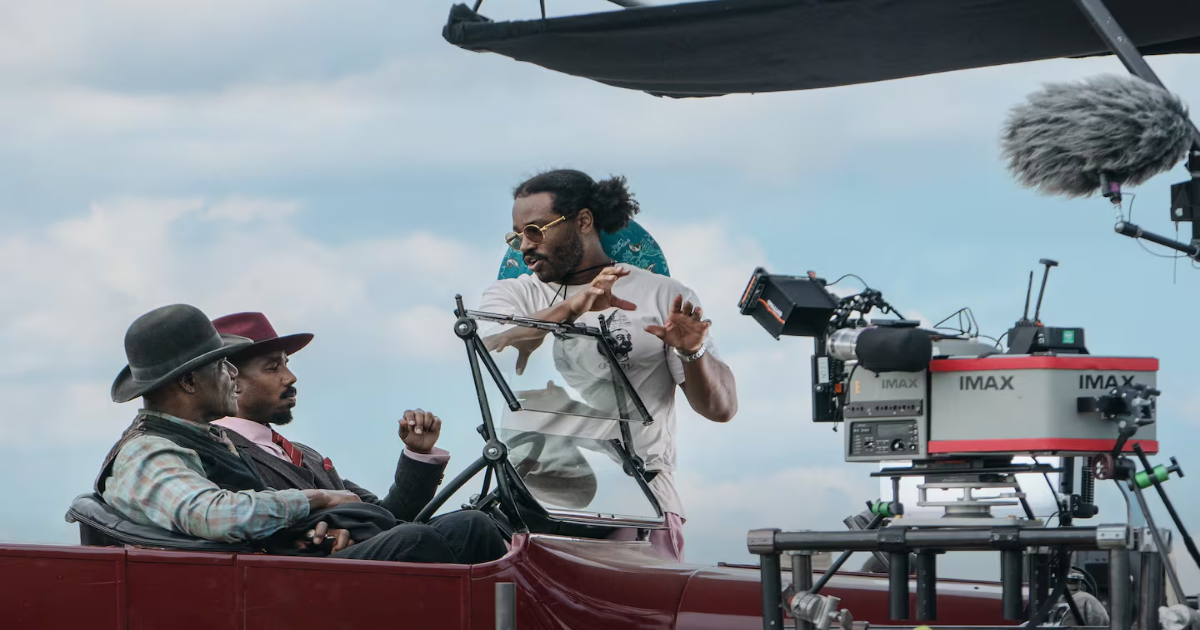“Mike’s very ambitious,” Coogler said of the actor taking on both roles on a recent video call with the Globe. “The bigger and bolder and more difficult the job is than something he’s done before, the more likely he is to say yes.”
The twins take a young blues musician under their wing called Preacher Boy Sammie (played by newcomer Miles Caton). He carries a steel guitar that he claims once belonged to the legendary Charley Patton, one of the real-life fathers of the Delta blues.
On opening night at the juke joint, a trio of white musicians show up singing traditional folk songs from the British Isles, accompanying themselves on banjo and fiddle. They turn out to be vampires. The vampires infect one twin’s girlfriend (played by Hailee Steinfeld), who then turns him into one of the undead. A prototypical battle of good versus evil ensues.
The film, says Coogler, is about dichotomies, beginning with the relationship between the church and the blues. Sammie is the son of a Baptist minister (Saul Williams), who fears for his soul.
Like a lot of Black men from the hip-hop generations, Coogler, who is 38, grew up feeling as though blues music was “not for me.” But he had a great uncle whom he admired and visited often, a man who loved the classic blues of Muddy Waters and Howlin’ Wolf. Making this movie, Coogler said, was his way of honoring his uncle.
“I wanted to explore that, and simultaneously make the movie that I always wanted to make in terms of the genre conventions that I love in cinema,” he said.
While writing the screenplay, he immersed himself in blues lore — the story, for instance, of Robert Johnson (who learned from Patton) supposedly selling his soul to the devil at the crossroads in exchange for his prodigious talent.
Coogler became fascinated with the recurring theme of blues musicians who had roots in the church, “like Son House,” he said, “who got sober and opened a church for a few years, then fell off the wagon and started playing blues again.”
While preparing to make the movie, Coogler learned about the murder of one of his favorite rappers, Young Dolph, who was from Memphis. Young Dolph often rapped about his brushes with death and his fear that he would die young, Coogler said.
“And it did happen, and I was really upset.”
But the death confirmed for him the connection between the storytelling of hip-hop and his uncle’s music.
“What gangsta rap was for me, the blues was for my uncle,” he said.
“I didn’t know until I went on the [Mississippi] Blues Trail how close Memphis is to the Delta. I talked to several Black musicians, and told me they identify more with the state of Mississippi than Tennessee.”
The blues tropes that Coogler plays with in “Sinners” should be taken with a healthy dose of skepticism, suggested the music historian Elijah Wald. A longtime folk guitarist around the Cambridge scene (and former Globe contributor) who now lives in Philadelphia, Wald has written more than a dozen books, including “Dylan Goes Electric!” (2015), the basis for the recent Bob Dylan biopic “A Complete Unknown,” and “Escaping the Delta: Robert Johnson and the Invention of the Blues” (2005).
The idea that the church considered the blues to be “the devil’s music,” Wald said, is true only to the extent that any music that inspired dancing would have been seen as such.
“That’s just as true for fiddlers,” he said.
What’s more, he said, the musicians we consider to be pioneers of the blues were in fact well-rounded musicians who could play many styles of music. They’re known as “bluesmen,” Wald said, primarily because the recording industry at the time was heavily segregated, only allowing these musicians to record what the executives believed to be “Black” music.
“Someone like Skip James or Charley Patton was playing the current pop tunes, and country music, and blues,” Wald said. “These were very versatile musicians.”
None of which is to say that as a music scholar who strives for historical accuracy, Wald takes exception with Coogler’s fantastical approach to the legends about “the devil’s music.”
“This is a popular fantasy, and there’s nothing wrong with working with it,” he said. “But a lot of it is fantasy.”
Coogler explained that he has had a lifelong interest in the idea of twins. His mother has twin sisters, one of whom is his godmother.
“They actually live next door to each other to this day,” he said.
In terms of horror movies, he’s always been drawn to the idea of the evil twin.
“I have a terrifying phobia of doppelgangers. It’s paralyzing,” he said with a laugh. The premise of his new film “is kind of an inside joke for people who really know me.”
Even as he’s confronting the heavy topic of racism, Coogler is clearly having fun with his twin story lines of demons and the blues.
“There’s a tendency to put all this mysticism on the deep, dark Delta, and have the blues be the voice of it,” said Wald.
But there’s one thing in particular about the story that he doesn’t dispute.
“Were white people vampires for Black people in the Delta?” he asked. “Hell yes!”
James Sullivan can be reached at [email protected].
